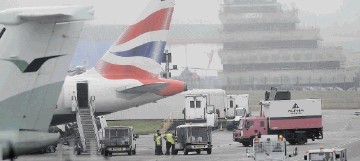
Anybody who has been stuck on a platform at the start of their shore leave will know – only too well – that fog can disrupt their plans, and at this time of year when the fog does come it can be particularly bad.
In my role providing weather forecasting and interpretation for commercial offshore operations, I have a very tricky job anticipating fog. It’s well acknowledged that it is an issue for people working offshore, but why does it occur and can we anticipate it?
Sea fog, like most fog, forms when moisture in the air is cooled to what we call its “dew point”. This is the temperature at which air will condense from water vapour into water droplets. This is the same effect you get when warm moist air comes into contact with a cold bathroom mirror. Quite frustrating when you are trying to shave or put on your lipstick!
While vapour is relatively transparent, droplets reflect light and reduce visibility. When this reduction in visibility gets below 1,000m it officially becomes fog.
So why do we get sea fog so much in the spring?
It’s common in spring because the change to warmer and moist air comes at a time when sea temperatures have yet to increase after winter. In this case, the sea cools the air in contact with it to its dew point.
As I write this, the sea temperature off Aberdeen’s coast is about 7°C. The dew point at Aberdeen airport (including the adjacent sea) is 5°C so, thankfully, that means there’s no fog!
However, if the air mass over the sea had a dew point of 7°C or more, then we would be thinking about the threat of sea fog. Perhaps we can be thankful for the relatively mild – albeit very stormy – winter we just experienced.
Forecasting fog is difficult because it depends on a complex mix of factors, some localised. We have to accurately forecast these factors – for example, wind, moisture in the air, local temperatures and so on – in order to accurately forecast fog. One small change in just one of these factors can make all the difference.
Things get even more complicated when you get a mixture of land fog, caused by localised cooling, combined with sea fog. This sometimes happens at Aberdeen airport and makes life very challenging, both for the Met Office aviation meteorologist and for people that make decisions based on the forecasts.
The team at the Met Office in Aberdeen supplies frequent forecasts and monitoring, round the clock, for Scotland’s airfields and for the North Sea, for both commercial and public use. Each and every day, the Civil Aviation Authority (CAA) and helicopter operators use this information to plan safe operations.
The risk of fog is a critical part of our forecasts and the information helps the airfields and the operators conduct their contribution to the oil and gas industry in an effective and safe manner.
Helicopter operators also have access to a bespoke commercial weather information system supplied by the Met Office called OHWeb. This system provides a comprehensive range of relevant warnings, real-time and forecast information and can be accessed from anywhere with an internet connection.
With safety paramount when it comes to offshore operations, the Met Office runs a selection of courses for the marine community that cover different aspects of meteorology. We’re running courses for helicopter operators in Aberdeen and Northeast England this summer. You can find out more at
http://www.metoffice.gov.uk/training/calendar
I have talked a lot about forecasts – looking forward – but we can also extract useful information by looking backwards, particularly when it comes to oil and gas companies planning operations or exploration.
We have a “hindcast” service which can analyse past forecast data from our numerical weather prediction models. This is particularly useful in areas with sparse data where a model might be the only source of weather information. Ideally, we would like to have long historical data records from real-time measuring instruments but these rarely match up with areas in which a company might be considering operations or exploration.
We can use data from these models to produce “synthetic climatology”, which is useful when planning specific projects. It can help a company anticipate the likely feasibility, costs and risks associated with a project in a defined location and at specific times of the year. This type of service has a wide variety of uses, from planning renewable energy assets to exploring new parts of the globe for oil and gas reserves.
Weather forecasting remains a considerable challenge, especially when it comes to the complexity of the factors determining conditions like fog. Despite the demands, with constant progress in science, technical and practical applications we can help people plan operations with confidence so they can remain as safe as possible.
John Mitchell is a metocean scientist at the Met Office
For more news follow @MetOfficeMarine
Recommended for you
